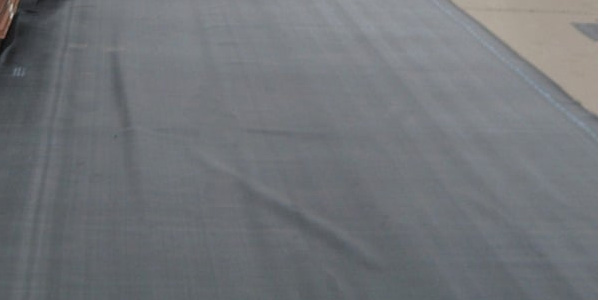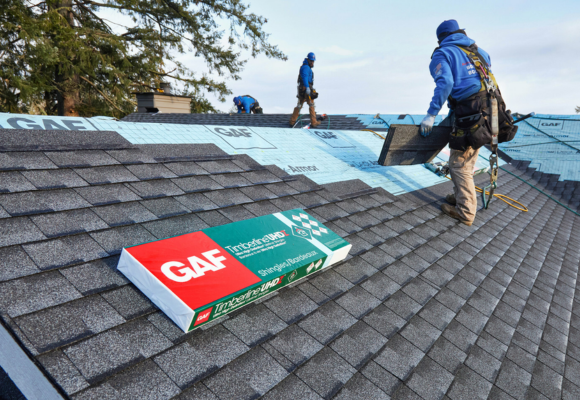Ever found yourself looking up at your rubber roof, contemplating whether shingles would be a suitable addition? You’re not alone.
Many homeowners and DIY enthusiasts have had this thought cross their minds.
After all, rubber roofs are renowned for their durability and water resistance, but can shingles further boost these benefits?
Can You Put Shingles Over a Rubber Roof?
Possible, yes. While it is technically possible to put shingles over a rubber roof, it’s not commonly recommended for several reasons.
Firstly, shingles and rubber are two very different roofing materials.
They expand and contract at different rates in response to temperature changes, potentially leading to weakening, cracks, and leaks over time.
Secondly, the added weight of shingles might overburden the roof structure, posing structural risks.
Shingles are significantly heavier than rubber, and the roof structure must be strong enough to bear this additional weight.
Thirdly, most building codes require removing old roofing material before a new roof is installed.
Installing shingles over an existing rubber roof may be against local building codes and regulations, depending on your location.
Lastly, if there are already issues with your rubber roof, like leaks or damage, covering it with shingles won’t solve these problems; it will only mask them.
Addressing and repairing existing issues is generally best before adding a new roofing material.
While installing shingles over a rubber roof might be technically feasible, it’s generally not the best practice due to potential problems with compatibility, weight, local codes, and underlying damage.
Always consult a professional roofer or a building inspector before making such decisions.
The Basics: Understanding Your Rubber Roof
To answer this question effectively, it’s important first to understand the ins and outs of rubber roofing. ‘rubber roof’ usually refers to an EPDM (ethylene propylene diene monomer) roof made from a highly durable synthetic rubber roofing membrane.

1. Durability: Rubber roofs are exceptionally durable and resilient. They can withstand harsh weather conditions, UV radiation, and physical impacts.
Proper maintenance ensures that a rubber roof lasts up to 50 years, making it a long-term investment for your home or business.
2. Water-Resistance: One of the main selling points of rubber roofing is its superior water resistance.
The seamless nature of a rubber roof leaves little room for leaks, making it an excellent choice for areas prone to heavy rain and snow.
3. Energy Efficiency: Rubber roofs are usually dark-colored, which allows them to absorb heat. This can help reduce heating costs during winter.
Additionally, you can opt for a lighter-colored coating for your rubber roof to reflect sunlight during summer, reducing cooling costs.
4. Low Maintenance: Rubber roofs require relatively low maintenance compared to other roofing materials. They resist dirt and mold, and stains can be easily washed off.
If a section of the roof gets damaged, it can often be repaired with special tape or glue, eliminating the need for a total replacement.
5. Eco-Friendly: Rubber roofs are typically made from recycled materials, making them an environmentally friendly choice.
Additionally, they can be recycled again at the end of their life cycle, reducing waste.
6. Cost-Effective: While the initial cost of a rubber roof may be higher than some traditional roofing materials, the long-term costs are often lower due to its longevity and low maintenance requirements.
Over the lifespan of the roof, you can end up saving money.
7. Easy Installation: Rubber roofs are relatively easy and quick to install, reducing labor costs.
They come in large rolls, which can be laid out and then adhered to the roof surface. This can often be accomplished with less time and effort compared to other roofing materials.
These advantages combine to make rubber roofs a compelling choice.
However, it’s important to note that every roofing situation is unique, and you should always consult a roofing professional before deciding.
What are Shingles?
Shingles are essentially roof coverings consisting of individual overlapping elements, often rectangular and laid in rows from the bottom edge of the roof.
The most common type of shingles in the U.S. is asphalt shingles.

Why Consider Shingles?
Shingles offer both functional and aesthetic benefits. They come in various styles and colors, allowing homeowners to customize their roofs to match their homes.
But could these cosmetic and functional benefits apply to a rubber roof?
1. Versatility: Shingles are suitable for various architectural styles.
Whether you have a modern or a traditional house, you can find shingles that complement its design.
2. Aesthetics: Shingles are available in various colors, textures, and styles. This aesthetic flexibility allows homeowners to choose a look that complements the exterior of their home.
Some shingles can even mimic the look of more expensive roofing materials, like wood shakes or slate, giving your home an upscale look without the hefty price tag.
3. Durability: High-quality shingles can withstand the elements, including wind, rain, and snow. Some types are also resistant to algae and moss growth, which can prolong the lifespan of your roof.
4. Easy Installation: Shingles are relatively easy to install compared to other roofing materials. This can reduce the installation time and labor costs.
Moreover, if a shingle gets damaged, you can replace the affected shingles without replacing the whole roof.
5. Cost-Effective: Shingles, especially asphalt ones, are among the most cost-effective roofing options.
They offer a good balance between cost and durability.
6. Sound Insulation: Shingles can provide good sound insulation, reducing the amount of external noise that enters your home.
7. Fire Resistance: Many types of shingles are designed to be fire-resistant, which can provide an added layer of safety for your home. Shingles can offer a range of benefits, from aesthetic appeal to functional advantages.
However, they may not be the best choice for every situation. Consider your specific roofing needs and consult with a roofing professional before deciding.
DIY vs. Professional Installation
When installing shingles over a rubber roof, you might be contemplating whether to take a hands-on approach or hire a professional. Here’s a deeper look into both options:
The DIY Route
1. Cost Savings: The most significant advantage of a DIY project is the potential cost savings. You can avoid labor costs associated with hiring a professional roofer by doing the work yourself.
2. Personal Satisfaction: A unique sense of achievement comes from completing a home improvement project yourself.
You have total control over the process, and the result directly reflects your effort and skill.
However, there are also several considerations:
1. Skills and Experience: Roofing installation requires specific skills and knowledge. Without the right experience, you may encounter difficulties or make mistakes that could compromise the project’s success.
2. Safety Risks: Working on a roof can be dangerous, especially if it’s high or sloped. Professionals have the necessary safety equipment and know how to navigate the hazards.
3. Time Commitment: A DIY roofing project can be very time-consuming, especially if you learn as you go. You need to be prepared for the commitment.
Professional Installation
1. Quality Workmanship: Professionals have the experience, skills, and tools to install the roof correctly. They know how to handle unexpected challenges that may arise during the installation.
2. Faster Installation: A professional roofer can complete the job faster than an amateur, thanks to their expertise and equipment.
3. Warranty Coverage: Most professional roofers offer a warranty on their work.
If there are any issues with the installation, they will fix it at no extra cost. On the downside, hiring a professional roofer can be more expensive than doing it yourself.
However, it’s important to consider the value of their benefits, including the peace of mind of knowing your roof has been properly installed.
Conclusion
Deciding whether to install shingles over a rubber roof isn’t a decision to be taken lightly. It requires carefully considering various factors, including cost, functionality, aesthetics, and local building regulations.
While this article has aimed to provide a comprehensive overview of the subject, it’s always best to seek professional advice before making any significant alterations to your home.
After all, your roof is a crucial barrier against the elements, and its integrity should not be compromised. In the world of home improvement, sometimes the best solution isn’t the most obvious one.
But with careful research and a thorough understanding of your home’s needs, you can make an informed decision that suits you best. Remember, you are the best judge when it comes to your home.
Make the right decision for you and your home will thank you.
Frequently Asked Questions
Can you install shingles over a rubber roof?
While installing shingles over a rubber roof is technically possible, it is not generally recommended due to several factors.
Shingles and rubber roofing materials have different expansion and contraction rates, which can lead to issues over time.
Additionally, shingles can add significant weight to the roof structure, potentially posing a risk if the structure is not designed to handle it.
Lastly, in many locations, local building codes and regulations may not permit installing a new roof over an existing one.
What can you put over a rubber roof?
Several materials can be applied over a rubber roof for repairs, maintenance, or enhancement. These can include rubber roof coatings designed to restore and protect the roof, extending its lifespan.
The coatings can also improve the roof’s resistance to UV rays and harsh weather.
Suppose you’re considering a more significant change. In that case, it’s essential to consult with a roofing professional to understand the implications and ensure the chosen material is compatible with the existing rubber roof.
Can you put asphalt on a rubber roof?
Asphalt is typically not recommended for use on a rubber roof.
The heat used in applying asphalt can cause damage to the rubber, and the two materials have different rates of thermal expansion and contraction, which can lead to potential issues like cracking over time.
What should you not put on a rubber roof?
Certain products and materials can cause damage to a rubber roof. These include petroleum-based products and solvents, which can cause the rubber to swell and loosen.
Sharp objects or abrasive cleaners should also be avoided to prevent damage to the roof.
Additionally, while it might seem beneficial to apply materials like shingles or asphalt over a rubber roof, as noted earlier, these are typically not advisable due to potential compatibility and structural issues.
Always consult a roofing professional before applying any new product or material to your rubber roof.

Arthur is a skilled roof worker with over 10 years of experience in the industry. He started his career as an apprentice and worked his way up to become a foreman.
When he’s not working on roofs, John enjoys with his family or writing posts. He is also a passionate cyclist.

